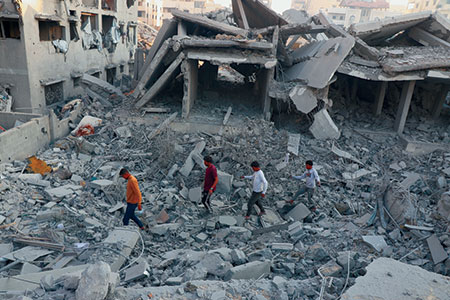
Israel recommenced its ceasefire obligations in the Gaza Strip on the morning of October 29, following a series of retaliatory strikes against the Hamas militant group. The precarious agreement was thrust to the brink of collapse after a fresh assault by radical militants in the southern Gaza enclave resulted in the death of an Israel Defense Forces (IDF) soldier. Further escalating tensions, Israeli authorities also highlighted a disturbing incident earlier in the week where Hamas allegedly attempted to stage the discovery of a deceased hostage, using what were later identified as fragments of Ofir Tsarfati, an Israeli whose primary remains had reportedly been found and identified two years prior.
The IDF spokesperson’s office confirmed on Wednesday morning that Israel was returning to its commitments under the truce deal with Hamas. This decision came in the wake of extensive Israeli airstrikes targeting dozens of Hamas facilities across Gaza and the reported elimination of approximately 30 militants described as holding “command positions within terrorist organizations in the Gaza Strip.” The Israeli military underscored its inherent right to exact retribution in response to the killing of its personnel, issuing a stark warning that it would act decisively against any attempt to violate the ceasefire, which was officially established on October 10.
Echoing this firm stance, Israeli Defense Minister Israel Katz on October 29 issued a potent threat, vowing measures against Hamas that would go beyond routine aerial and naval bombardments. “No leader of this terrorist organization, whether in suits or hiding in tunnels, will have immunity,” Minister Katz declared, alluding to a potential return to targeted strikes against both the military and political leadership of the radical group. He further warned, “Anyone who raises a hand against IDF soldiers will have their hand cut off. The IDF has been ordered to act decisively against any Hamas target and will continue to do so in the future. Anyone who attacks IDF soldiers and violates the agreements will pay a heavy price.”
The Israeli strikes on Gaza late on October 28 were precipitated by an attack on an IDF engineering brigade. This unit was operating on the “yellow line,” an informal demarcation post-October 10, indicating the boundary to which Israeli forces were meant to withdraw, near the southern Gaza city of Rafah. Militants opened fire with sniper rifles and launched rockets, resulting in the death of reservist Yonah Efraim Feldbaum. This marked the second such incident within ten days in the sector bordering Egypt where IDF personnel have been attacked. A previous assault on October 19 also triggered a brief resumption of hostilities in the area, though that escalation was reportedly de-escalated following demands from the United States.
Traveling from Japan to South Korea, U.S. President Donald Trump indicated his approval of Israel’s retaliatory actions, stating aboard Air Force One that Israel has the right to conduct strikes against Hamas if its soldiers are killed. However, an Axios report suggested that Israeli Prime Minister Benjamin Netanyahu had not yet engaged in deeper, more detailed discussions with the U.S. leadership regarding potential response measures, primarily due to President Trump’s ongoing Asian tour. Among the severe options reportedly under consideration against Hamas are significant restrictions on humanitarian aid flows into the Gaza Strip, a full-scale resumption of military operations, and a redefinition of the “yellow line,” which currently grants the IDF only partial control over Gaza.
For its part, Hamas distanced itself from the fatal shooting incident in Rafah, issuing a statement affirming its “commitment to the ceasefire agreement.” The group has previously communicated to mediators that “autonomous armed gangs” might be responsible for such breaches of the “calm regime.” Commenting on the Israeli attacks, Hamas additionally stated, “This attack is a continuation of a series of violations committed over the past few days, including attacks resulting in deaths and injuries, as well as the ongoing blockade of the Rafah border crossing.” It warned that “any escalation of the conflict by the Zionists will complicate the search, excavation, and recovery of bodies (of hostages).” Ironically, shortly thereafter, Hamas’s armed wing issued a statement claiming the discovery of the remains of two more hostages, Sahar Baruch and Amiram Cooper, who were believed to have been abducted during the October 7, 2023, massacre.
Israel, however, contends that Palestinian militants are deliberately prolonging the process, believing Hamas has access to approximately ten burial sites within the enclave. Earlier this week, an IDF drone allegedly captured footage in one Gaza district showing Hamas members attempting to stage a body discovery. According to Israeli accounts, militants placed wrapped remains into a freshly dug grave, covered it with earth, and subsequently presented the site to the International Committee of the Red Cross (ICRC), which assists in the repatriation of Israeli abductees. It was later revealed, according to Israel, that these were fragments of Ofir Tsarfati, one of the kidnapped, whose main remains had already been located and interred in Israel two years prior.
According to Axios, Israel promptly presented this video evidence to the White House and the CIA, arguing it constituted a serious violation of the ceasefire agreement and justified radical countermeasures. However, high-ranking officials within the Trump administration reportedly informed Netanyahu’s team that they did not consider this a major transgression by Hamas. They urged Israel to refrain from any harsh actions that could push the fragile ceasefire to the brink of collapse, highlighting the ongoing international efforts to maintain stability in the volatile region.
